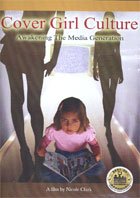
Cover Girl Culture 2009
Distributed by Women Make Movies, 462 Broadway, New York, NY 10013; 212-925-0606
Producer n/a
Directed by Nicole Clark
DVD, color, 80 min.
College - Adult
Women's Studies, Gender Studies
Date Entered: 02/22/2010
Reviewed by Ciara Healy, Technical Services Librarian, Polk Library, University of Wisconsin-OshkoshThe film Cover Girl Culture attempts to be a scathing indictment of the fashion industry, particularly fashion magazines aimed at teenage girls, such as Teen Vogue. While the documentary is indeed scathing, it is also relentless and once you “get it” about the fashion industry, at about 10 minutes into the 80 minute run time, you keep getting it and getting it until you have so thoroughly gotten it, that you almost start rooting for the super thin models and their industry apologists.
None the less, Cover Girl has some strength. If a professor were willing to pull clips to show in class, they would be able to build an excellent 25 minute exposé of the fashion industry via interviews of the editorial staff at Teen Vogue magazine in Canada. These interviews would have made an excellent, shorter version of Cover Girl Culture that shows women working in an industry that, contorting themselves to avoid admitting, undercuts the self esteem of real girls and women every day through the depiction of other women and girls on the pages of fashion magazines. In these interviews with industry insiders, we learn that, among other things, the fashion industry is about profit, fantasy and healthy, creative, active, happy girls. The deliberate caution with which the women respond is deliciously cringe-worthy, until you realize that their jobs may hang on their answers and that they know well what the feminist criticisms of their industry are, and don’t really have a response other than to shift the blame another sector – Hollywood, gossip magazines, reality shows, society at large – to explain why there exists so many girls with low self esteem, destructive body image and eating disorders.
One of the least successful aspects of the film, interviews with teenage girls, seems at first to be another strength. There are several scenes where girls are interviewed, some who want to be models - to be perfectly beautiful, adored and famous - and some whom have been through a one-hour “Girls Media Literacy Forum” who are then given a fashion magazine to scorn for the camera. While the inclusion of actual teens in the film is requisite, what the girls actually say undercuts the thrust of the feminist critique, especially the girls who are hyped up after the Literacy Forum. Interestingly, after a thorough and informed group-critique of a fashion magazine, one of the girls says “but we still all want this” and the scene quickly cuts away. The more difficult issue of what to do about inundating images of female beauty and perfection – that they “work” on girls and women who often know better – is left unaddressed. And that is the real question. Tilting the windmill of the fashion industry is easy – so easy an 11 year-old girl can learn to do it in an hour of “media literacy forum” training – and while this film looks thoroughly at every aspect of the critique, it takes the easy way out in the end.
Cover Girl Culture doesn’t cover any new ground compared to Killing Us Softly and its sequels, the standard films selected for this moment in Intro to Women’s Studies courses. While Cover Girl does not present a viable alternative, it does offer new and updated visuals, which is a definite improvement over Killing Us Softly’s print-based “You’ve Come a Long Way, Baby” cigarette ads and disco models. Overall, it would be a good addition to large academic libraries supporting visual communications and journalism programs, American Studies and masters or Ph.D. programs in women’s or gender studies.